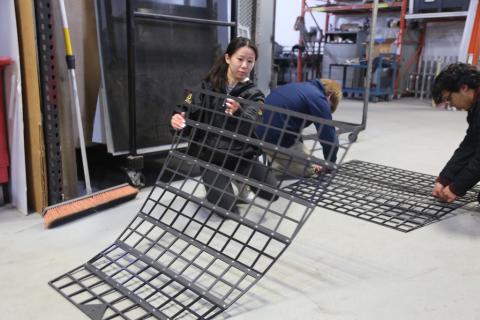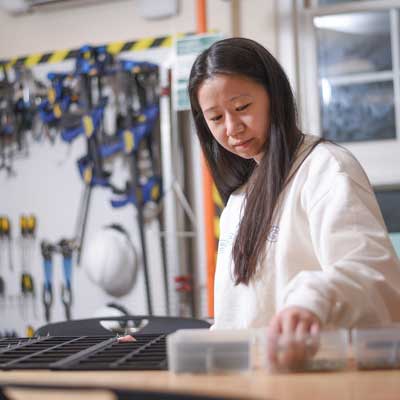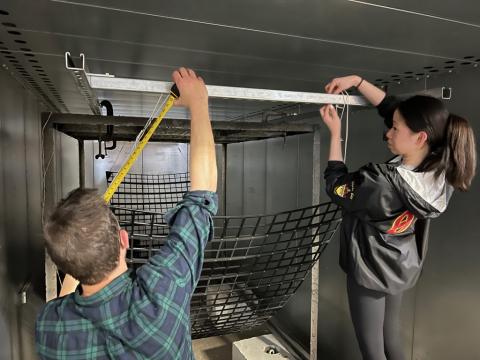
Civil Engineering Major
Esther Zhang ’22
Civil engineering student Esther Zhang ’22 had spent the better part of a year working on her senior thesis project that combined her passions: a massive arched structure made of renewable materials to serve as a visual representation of a more sustainable future.
Then, it all fell apart – literally.

At the end of construction, while the plastic structure was “cooking” in an industrial walk-in oven used to set its shape, the arch sagged in the middle.
“I put in so much effort and seeing it come out and not be what I wanted, it was really defeating,” said Zhang. “I took a moment and thought about ways I could push through and save this piece to still be something that I can display and be proud of.”
And so “Resilient” was born. Rather than one large archway, Zhang pivoted and created a design that would accentuate the sag – form two separate structures, each spanning six feet in length and reaching heights of over six feet.

Esther preparing her project to be forged in an industrial oven.
“The name…describes my own journey in college,” Zhang said. “This project is in many ways a culmination of my experiences here at Hofstra and is symbolic of me making it through to the end.”
“The past year has been particularly rough for me,” she said. “Although I started the fall semester so excited to be able to see everyone again, my mental health took a huge hit trying to adapt back to a normal life as much as possible. I had many hard days where I was ready to give up on all of my responsibilities as a student, but I pushed through with the help and support of a lot of people around me.”
Zhang’s mentor, engineering professor Dr. Edward Segal, said it’s unusual for students to undertake senior design projects of such a large scale.
“The effort and energy she puts into her projects is beyond a typical undergraduate,” Segal said. “All of the iterations needed for this kind of project can be intimidating or discouraging because you get to a point and you have to back track or start over. Design isn’t linear. And she just kept coming back and pushing through.”
"This project is in many ways a culmination of my experience here at Hofstra and is symbolic of me making it through to the end."
ESTHER ZHANG ’22
hang, a first-generation college student from Flushing, New York, was drawn to engineering after a lifelong interest in buildings. But she wanted to find a way to pair that interest with her passion for sustainability issues.
Enter Dr. Segal, an assistant professor at the Fred DeMatteis School of Engineering and Applied Sciences, who specializes in exploring and using renewable materials in engineering. He was working on a research project to find ways to make use of the acrylic shields produced as protection during the COVID-19 pandemic and needed student assistants.
After spending the summer of 2021 conducting research on what was being done with plastic waste and the forms that can be generated from it, Zhang got the idea of building on one of Dr. Segal’s previous acrylic projects, but changed the material and shape.
The idea became her senior design project.
Watch the CBS2NY Story About Esther's Project
Zhang decided on using polylactic acid (PLA), a type of biodegradable plastic commonly used in 3D printing that can be manipulated into different shapes and structures when exposed to heat.
The structure began as a flat grid, and its curves were created with heat by hanging the flat structure from a frame in an industrial manufacturing oven.
Smaller prototypes were designed, produced, and reshaped using facilities at Hofstra to identify exactly how to hang the structure so the curve matched Zhang’s design. Once the prototype experiments were completed, she had to figure out how to build the project to scale.

Esther and Professor Segal hanging the project in the industrial oven at a facility in Bethpage, NY.
“It was challenging for me to think outside of the box of what I’ve learned in the classroom and apply those concepts to the project,” said Zhang. “You learn more about the stresses on a structure and what makes it stand, but you don’t think about how things actually get constructed down to things like hole diameter and bolt size.”
Over the course of weeks, the 30 pounds of plastic required to complete the project were printed in shapes of various lengths, from a few inches to five feet. Each piece was then drilled and bolted together to create the grid that would become the archway.
What she didn’t account for was that the walk-in industrial oven she used to forge the final structure at a facility in Bethpage, N.Y. ran hotter than the small industrial oven on campus when set at the same temperature.
That resulted in the material slumping against its support frame, ruining the original design concept for a single, seamless archway.
In the moments that followed, Zhang immediately understood what she needed to do. She had to be flexible, like the PLA plastic she was working with.
“The dictionary defines resilient as ‘capable of withstanding shock without permanent deformation or rupture’” Zhang wrote in the description of her project, which is now on display in Axinn Library, where it will stay until commencement in late May. Before that, it was exhibited in Hofstra’s FORM gallery, which is a space for students of all majors to display their artwork.
“When something is this elegant, it’s tempting to think that the process to create it is simple,” said Segal. “A lot of energy and effort went into making something very easy to interpret like this. To have it be able to all come together, the difficulty and complexity falls away.”
Watch a time lapse video of the construction of Esther Zhang’s senior design project Resilient

